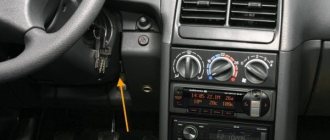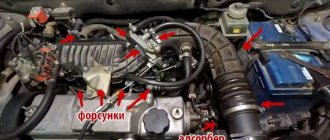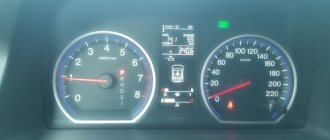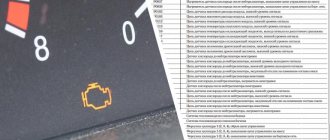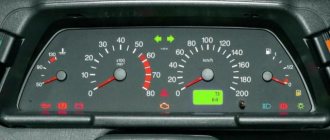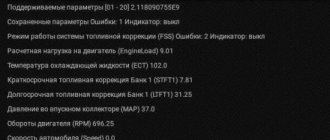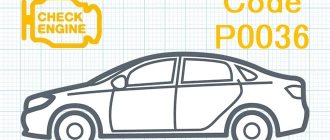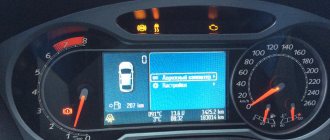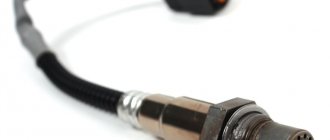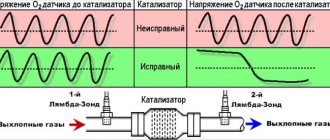What does P0172 mean?
Trouble code P0172 indicates that there is too much fuel in the air-fuel mixture. The engine control module (ECM) controls the air-fuel ratio based on data from the mass airflow sensor, oxygen sensors, and manifold absolute pressure sensor.
Most often, the ratio of air and fuel in the mixture is determined based on the readings of oxygen sensors by calculating the amount of oxygen and carbon monoxide in the exhaust gases. The most optimal ratio of air and fuel in the mixture supplied to the engine cylinders is 14.7:1. It is this ratio that is necessary to achieve maximum engine power and optimal fuel consumption.
The vehicle's ECM may slightly adjust the air/fuel ratio if the mixture is rich. However, if the mixture contains too much fuel and not enough oxygen, the P0172 code appears.
How to remove error P0172
The test must be done from simple to complex. That is, the simplest thing is to check whether there is air leakage on the intake and exhaust manifolds, then check the spark plugs, spark plug wires (there are often broken wires) and the ignition coil. For a complete check, you also need to check the lambda probe, MAF, and DTOZH sensors with a multimeter. Then check the ignition marks and fuel pressure with a pressure gauge.
After eliminating the found cause, you need to reset the fuel supply adjustment. Typically, P0172 errors are resolved by flushing or replacing the mass air flow sensor and oxygen sensor.
Recommended Tools to Fix P0172
There are several important tools that will help you fix the P0172 trouble code. These tools include:
- Car charger.
- Multimeter.
- OBD-II scanner.
- Pressure gauge.
- MAF cleaner.
What needs to be repaired to resolve P0172?
- Repairing leaky vacuum hoses
- Replacing a faulty fuel injector, fuel pump or fuel pressure regulator
- Replacing a clogged VAZ air filter
- Replacing the thermostat or coolant temperature sensor
- Replacing spark plugs
- Replacing or cleaning the mass air flow sensor and oxygen sensors
How to return the mixture to normal
If the problem is similar to those described above, you should contact a competent diagnostician. Sometimes the cause of a rich mixture can be eliminated by adjusting the throttle valve or injector. In other cases, replacement of “flying” sensors is required. Therefore, a specialist is needed who has the knowledge, experience and equipment to conduct a comprehensive diagnosis.
Chip tuning can eliminate problems with the oxygen sensor (lambda) - this is one of its functions. When choosing this solution, trust the professionals to reprogram the control unit (ECU).
Common mistakes when diagnosing code P0172
The most common mistake when diagnosing a P0172 code is not checking the coolant temperature sensor and cooling system. If the engine is cold, more fuel is added to the fuel mixture so that the engine can warm up to the required temperature. If the coolant temperature sensor is not working properly, it sends an erroneous signal to the vehicle's ECM, which in turn may assume that the engine is constantly cold. This may result in the mixture becoming too rich.
How to troubleshoot P0172
Fuel trim monitoring uses the oxygen sensor to operate, meaning fuel trim codes are not oxygen sensor codes.
- Code P0172 together with error P0175 or errors in the mass air flow sensor. If you see a P0172 with a P0175 code or MAF-related errors at the same time, you can likely rule out individual cylinder, ignition, and fuel injector problems. Instead, focus on the fuel injection system and air flow sensor.
- Contamination of the air flow sensor can distort air measurements, so the fuel injection calculations are changed. Cleaning may solve the problem. Replacing the sensor, along with a new air filter and properly sealing the air ducts, would be a more reliable solution.
- Check fuel pressure. Make sure it is in the proper range. Excess pressure, for example caused by a faulty pressure regulator or a pinched return line, will cause more fuel to be injected than the ECU expects.
- Check that the DTOZH (coolant temperature sensor) and IAT (intake air temperature) sensor readings are correct . The control unit may not detect faulty sensors, so it is useful to check that the temperature sensors are within normal ranges. For example, if the engine was running for half an hour on a hot day, the DVT value should be at least 80 °C. If the ECU still reads 0°C, it will enrich the FA ratio to compensate, resulting in an over-rich condition.
- P0172 with other Bank 1 DTCs. If you only have a P0172 with simultaneous Bank 1 DTCs, such as cylinder misfire, then focus on Bank 1.
- Fuel pressure drop. With the engine running, record the fuel pressure, then stop the engine. Fuel pressure may drop slightly but should remain stable for at least 10 to 15 minutes. If fuel pressure continues to drop, you may have a leaking fuel injector, resulting in a rich condition and possible misfire.
- Misfire in the cylinder. A cylinder misfire will result in the release of unburned fuel into the exhaust stream. Diagnose and correct leaks before attempting to diagnose a rich mixture. Pay attention to associated error codes such as VVT (variable valve timing) or ignition system.
- Exhaust. Check the exhaust for leaks between the cylinder head and the oxygen sensor. Although the exhaust system appears to be a positive pressure system, air can enter the partial vacuum created by the exhaust gas pressure pulses. Atmospheric oxygen arriving before the DC distorts oxygen measurements.
Eliminating the error: mixture too rich
Therefore, in order to find the culprit component or system, you will need to check the MAF, DTOZh and lambda probe sensors with a multimeter. Then check the voltage and wires. Measure with a pressure gauge. Check the ignition marks. And also check the connections at the air intake and exhaust manifold for presence.
Once the problem has been resolved, you will need to reset the fuel trim to reset the long-term trim to 0%.
By following all the recommendations, you will probably be able to cope with incorrect engine operation and the setting of error code P0172 both in VAZ and foreign cars like Toyota or Mercedes, as well as other cars with electronic controls. Although it is often not necessary to complete all the points, in most cases it is necessary to flush or replace the mass air flow sensor or oxygen sensor.
What should the fuel-air mixture be?
Under ideal engine operating conditions, the amount of air should exceed the amount of fuel by 14.7 times. That is, for one drop of fuel there are 14.7 “drops” of air. This ratio is called stoichiometric and is most useful in terms of engine efficiency.
A rich mixture is a violation of the “golden” rule. Within certain limits, a slight enrichment can give an increase in power, but everything has a limit, beyond which a malfunction occurs.
How to tell if a mixture is rich
Several characteristic features:
Signs of a rich mixture on a VAZ-2114
A too rich mixture on a VAZ-2114 manifests itself not only by issuing error p072, but also by the following symptoms:
- high gas consumption. Moreover, consumption increases sharply and is explained by inefficient consumption of the fuel mixture;
Soot on the spark plug with a rich mixture
- loss of engine power. A mixture in which the air content is less than normal burns more slowly than usual, and often not completely. As a result, the piston is not provided with optimal force, which is why the engine power decreases;
- black smoke from the exhaust pipe. The reason lies in the lack of filtration of gas from gasoline combustion;
Black smoke with rich mixture
- the appearance of strong pops in the muffler. The reason is a lack of air in the engine cylinders.
Rich - lean mixture
Next, the closed loop algorithm comes into effect (in English terminology – closed loop). By constantly analyzing the signal from the oxygen sensor, the controller changes the composition of the fuel mixture every time the sensor voltage crosses the threshold corresponding to the stoichiometric mixture (ideal fuel/oxygen ratio). Therefore, when the engine is running, the voltage at the output of the lambda probe has a form close to a sinusoid.
As soon as the voltage rises (the mixture turns from lean to rich), the controller, after waiting some time, begins to gradually reduce the injection time, making the mixture leaner. This continues until the voltage at the oxygen sensor drops, indicating that the mixture has become lean. Further, the injection time increases again - therefore the algorithm.
Since, as the vehicle is used, real operating parameters may seriously deviate from the ideal ones specified by the firmware, a long-term correction parameter for the mixture composition is used. It is set by an algorithm and its work can be explained as follows: if for a long time the short-term correction (set by the lambda probe) deviates significantly from zero, then the average value of the deviation is taken into account when calculating the opening time of the injectors even before applying the short-term correction.
For example, our faulty fuel pressure regulator overestimates the amount of fuel that actually enters the cylinders at the estimated opening time of the injectors. Accordingly, the moment of transition from a lean to a rich mixture via the lambda probe will take place with a negative value of the short-term correction: the mixture will have to be leaner constantly. The self-learning algorithm will remember this negative correction.
Thus, even with serious deviations in data from the sensors and the actual state of the engine, the injection system maintains the specified mixture composition. However, any correction has its limits, and when the correction parameters go beyond the limit values, the Check Engine indicator will light up.
Other signs
Of course, there are many reasons for excessive fuel consumption. But usually the first sign here is code P0172.
There are also a number of other signs of a problem:
- Loud pops are heard from the muffler;
- the smoke coming out of the chimney is black or dark gray;
- power is lost.
Noisy exhaust occurs more often at high speeds. The reason is that the fuel does not burn completely and is therefore discharged along with the gases to the outside. However, in its path there is a muffler that does not allow fuel to pass through, so it accumulates in it and explodes when it reaches a critical mass. As a result, there is a risk of destruction of the muffler itself or the resonators.
Blackish smoke comes out due to the fact that the combustion of gasoline residues occurs in the exhaust system, where the products formed during ignition are not filtered.
The loss of power is due to slow and incomplete combustion of fuel. As a result, it literally floods the candles, which leads to the loss of spark and, accordingly, to an even worse situation. In this situation, the piston does not receive a normal push and a decrease in power occurs. Sometimes this indicator is restored for some time after the car is driven at high speed, but usually the improvement does not last long.
Under such circumstances, gasoline consumption cannot but increase. The presence of a malfunction in the system does not prevent fuel from flowing into the engine, but it is used there with very low efficiency. A significant part of it is simply thrown into the wind, and in the literal sense.
Other reasons
Quite often, the cause of the error in question is not gasoline, but air. The latter, in turn, may be supplied too little. Here you will need to check the functionality of the air filter. It sometimes gets clogged and eventually stops performing its main function.
If there are no complaints about the operation of this element, then the reasons may be the following:
- incorrect injector settings;
- DMRV failure;
- increased pressure in the fuel system;
- fuel getting into the lubricant.
In the first case, the opening and closing of the injectors often occurs at the correct intervals, but each time the dose of gasoline is injected too large. It is almost impossible to check the serviceability of this element at home, so you will have to visit a car repair shop. As a rule, nozzles that have become unusable are replaced with new ones.
A breakdown of the mass air flow sensor results in the on-board computer receiving incorrect data on air consumption, which forces the proportions to be changed in favor of increasing the proportion of fuel.
Often, when the check engine light comes on, the diagnostics display error p0172. This means only one thing: the mixture in your car’s engine is too rich. But why is she rich? There may be several answers here; let’s try to understand the main reasons for the rich mixture.
So the problem arose out of the blue? The scanner showed an error, saying the mixture is too rich, dude. And the diagnostician took the money and said, look further yourself, I did the diagnostics
In addition to the scanner, you can also be told about the presence of an over-enriched mixture in the engine of your car when measuring CO and CH during a technical inspection. In general, it doesn’t matter where you learned that there is such a mixture in the engine; to troubleshoot a problem, you must understand what the very concept of this mixture means.
When there is too much gasoline and not enough air in the fuel-air mixture, such a mixture is called rich.
The easiest thing to look for is in the fuel supply system (lots of fuel), or in the air supply system to the combustion chamber (little air). Don't forget to start.
Causes related to the fuel system:
- Too much pressure in the fuel line. And there may be several more sub-points. High pressure may be due to a faulty fuel pump. Or it could be due to a faulty fuel pressure regulator. There is a special fuel pressure gauge that is used to check the fuel pressure.
- The adsorber is not working properly. That is, the vapor recovery system is faulty. In this case, there may be too much fuel entering the inlet through the adsorber, and this is the reason for the rich mixture.
- Injector malfunction. Tested on a stand for . That is, the injectors (nozzles) simply do not keep the fuel closed, and this is a reason for it to get into the cylinders even with the nozzle closed.
Causes related to air supply:
- Clogged air filter. Trite? Yes. But this happens all the time, so check it out. Just keep in mind that if, when checking the air filter, you suddenly find that it is covered in oil, then the engine is bad... almost.
- Also, a malfunction of the mass air flow sensor can cause a rich mixture. Or a manifold air pressure sensor. In any case, this is checked by, namely by the parameters of voltage and air flow or by the absolute pressure in the intake manifold.
This is where the main types of appearance of a rich mixture end and rare or exotic remain. Such as poor contact condition, error in the control unit itself
A rich mixture is a violation of the “golden” rule. Within certain limits, a slight enrichment can give an increase in power, but everything has a limit, beyond which a malfunction occurs.
Error conditions
The engine must be started and the fuel supply occurs with feedback from the oxygen sensor (lambda probe), and there is no error from the coolant sensor, intake air temperature sensor, absolute pressure (MAP - sensor), DPPV, DPKV and throttle position sensor. When the average total values of short-term and long-term fuel trims are less than 33% for just over 3 minutes out of the 7th test period. The indicator light on the instrument panel will go out only if the diagnostics does not detect a failure after three test cycles.
